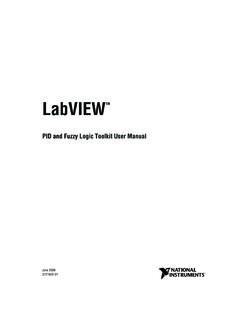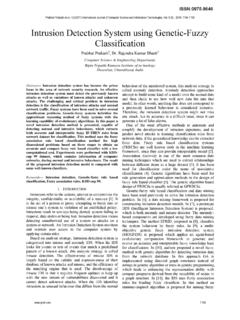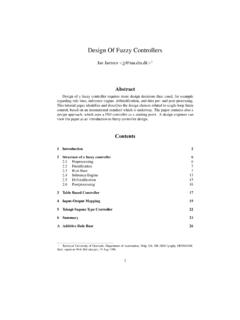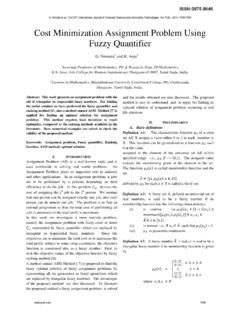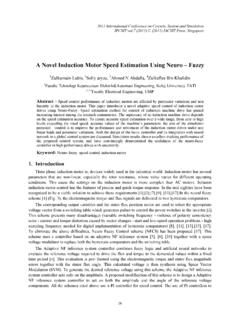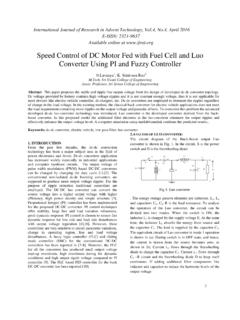Transcription of Valuing M&A Synergies as (Fuzzy) Real Options
1 Valuing M&A Synergies as ( fuzzy ) real Options Jani Kinnunen Institute for Advanced Management Systems Research bo Akademi University Joukahaisenkatu 3-5 A 4th floor 20520 Turku, Finland Email: March 13, 2010 Abstract This paper views operating Synergies as real Options that acquiring companies have in the post-acquisition M&A process. The paper builds on the synergistic restructuring theory, which states that both acquisitions and divestitures are wealth-creating activities. Acquisition Synergies are broadly defined as arising both from resource redeployments between the acquirer and the acquisition target company and the executed divestitures of target s assets within the post-acquisition process. We present a procedure to ex-ante calculate the first approximate value of the Synergies in the screening stage of the M&A process. We argue that Synergies are highly uncertain and require significant management actions and, for that reason, an appropriate method for the valuation is the fuzzy real Options pay-off method, which is presented as an integrated part of a decision support system built for the screening of potential acquisition targets.
2 The paper also discusses the ordering of acquisition candidates according to their total value based on the presented fuzzy measure. Keywords: Synergy real Options , Divestiture, Mergers and Acquisitions, Acquisition Screening, Decision Support System, fuzzy Pay-Off Method 2 1. Introduction There are many ways to measure the success of mergers and acquisitions (hence M&As) from the acquirer s point of view. Aspects that can be measured range from creation of value, to improvements in financial stability, strategic position, organizational strength, brand, or the whole M&A process (Bruner, 2004b, 2005), and to capture of value (Capron and Shen, 2004), the last one referring to M&A deals closed under the fair-value of the target. We focus on the value creation opportunities and improvements in the M&A process. Also, the capture of value is included implicitly in our analysis, when we compare the total value of a target with the price of the target at the end of the paper.
3 We will show that the value creation opportunities and the total value of a target can be valued ex-ante, in the pre-deal stage, using a real Options approach, and we will argue that the use of the structured screening and the fuzzy pay-off method for real Options valuation can improve the M&A process, when they are integrated to a decision support system (hence DSS), which we have built for the screening of potential acquisition target companies together with senior managers from a large listed active acquirer through a strategy development project jointly financed by Tekes (Finnish Technology Agency) and the corporate partners. The DSS is presented in the paper with a focus on its synergy module. We focus on operating (sales increasing and cost reduction) Synergies , while potential financial Synergies taken into account in our DSS (related, , to lower cost of capital, dept capacity, reductions in working capital and capital expenditures, or tax benefits) are not discussed in this paper, but we note that they can follow from an acquisition and also be reflected in integration and divestitures (of assets or business units), which are argued to support the creation of operating Synergies .
4 We include divestitures in the analysis of operating Synergies . We argue that it is an inherent part of the restructuring process of creating such Synergies , because preparing for divestitures can be seen as an inverse action to integration required for synergy gains. To the best of our knowledge this is a new approach. Further, divestitures can release resources and ease management s attention on synergy creation, and the approach is supported by the literature reviewed in the next chapter. Chapter 2 discusses the concepts and the real Options valuation framework applied in the paper. Section discusses the importance of synergy for M&A rationales focusing on the key sources of Synergies , , restructuring including resource redeployments and divestitures, and, based on that, presents a decision process to create synergistic gains. Section presents a total value concept as the valuation approach from the acquirer s perspective and discusses the synergy real Options available in the post-acquisition process.
5 Chapter 3 presents the synergy module of the DSS built for the screening of acquisition targets. The chapter presents the cost reducing and sales enhancing Synergies including asset divestitures, as they are built in the DSS. Chapter 4 presents the fuzzy pay-off method integrated to the DSS with an example to illustrate its applicability to value operational Synergies together with related divestitures. Chapter 5 concludes with a discussion of the presented approach to corporate acquisitions and synergy real Options with possible benefits and limitations of our approach, and suggests further research opportunities. 3 2. Synergy real Options in M&A Decision Sequence Synergy Creation Process Acquisition motives include at least the following wealth-increasing motivations for corporate takeovers (cf. Bradley et al., 1986; Bruner, 2004a, 2004b; DePhamphilis 2009; Healy et al, 1992; Krishnamurti and Vishwanath, 2008; Pablo and Javidan, 2004; Seth, 1990; Walker, 2000).
6 Firstly, acquisitions can increase efficiency by creating economies of scale or scope. Secondly, takeovers can exploit asymmetric information between acquiring-firm managers and acquiring- or target-firm shareholders. Thirdly, acquisitions can mitigate agency problems associated with the firm's free cash flows. Fourthly, takeovers can enhance the acquirer s market power. Fifthly, acquisitions can lead to tax benefits. DePhamphilis (2009) notes that the most common motive for M&As is synergy. While operating Synergies arise primarily from economies of scale and scope (DePhamphilis, 2009; Houston, James, Ryngaert, 2001), we argue that synergistic gains can legitimize all the above-mentioned motivations for M&As. This follows from our broad definition of synergy according to which all the value of the combined firm that comes above the value of the acquirer and the target as stand-alone entities accounts for the value of synergy.
7 The definition is in line, , with Khrishnamurti and Vishwanath (2008) and Seth (1990). The post-acquisition process has been pointed out as the most crucial phase of value creation (Agrawal and Jaffe 2000, Epstein, 2004; Harding, Rovit, and Corbett, 2004; Hitt, King, Krishnan, Makri, Schijven, Shimizu, and Zhu, 2009; Khrishnamurti and Vishwanath, 2008). Post-acquisition integration is where envisioned Synergies and expectations are realized or broken. Failing in the ex-ante analysis of post-merger issues can lead to problems already at the bargaining table during the negotiation stage, as well as, in the post-merger implementation (Bruner, 2004b). Integration is a transformation process vital to the success of an M&A, , Habeck, Kr ger, and Tr m (2000) report that post-merger integration is the primary reason for failure in 53% of all unsuccessful deals. A survey of KPMG (1999) shows that ex-ante/pre-M&A synergy evaluation is the most important factor behind a successful M&A; it increases the probability of success by 28% according to respondents.
8 Operating Synergies are generally responsible for the major part of the value creation potential in M&As in addition to financial Synergies ( , Anslinger and Copeland, 1996; Khrishnamurti and Vishwanath, 2008) and (other) growth Options ( , Kester, 1984; Smit and Trigeorgis, 2006; Smith and Triantis, 1995; Vishwanath, 2009). An opportunity of creating revenue increasing synergy can be seen as a type of growth option. Growth can be sought, , through increases in market share, expansions to new geographic or new product markets, or through R&D acquisitions (Bower 2001, 2004; Ficery, Herd, and Pursche, 2007; KPMG, 1999). Such growth opportunities are the most typical examples of growth Options . We will discuss this further in section and we will illustrate with an example in Chapter 4 that growth Options (also ones, which are different from our operating synergy Options ) can be added in the analysis analogously to how we handle Options to create Synergies and to divest.
9 Drivers of operating Synergies and the long-term performance of M&As is studied by 4 Capron (1999) and Capron, Mitchell, and Swaminathan (2001). Capron (1999) builds a theoretical model for long-term acquisition performance based on value-maximizing theory rooted in the cost efficiency theory (economies of scale and scope) and in the resource-based view (utilization of core competencies and resources). He shows empirically, based on a survey of acquiring firm managers of 253 horizontal acquisitions ( , acquisition of a business within the same industry) on European and American manufacturing companies, the causal links between the post-acquisition actions and cost savings and revenue enhancements. The earlier paper of Mulherin and Boone (2000) studies acquisitions and divestitures separately. However, the authors state that their paper is the first one studying both of them within one study. They report industry clustering for both acquisitions and divestitures, which suggests that both synergy and divestiture gains represent empirically important explanations for M&A activities.
10 They state that both acquisitions and divestitures support the synergistic theory of restructuring activities as opposed to activities based on managerial hubris, empire building, or firm-size maximizing theory. Capron (1999) shows that resource redeployment and asset divestiture drives the long-term acquisition success, noting also that there is a significant risk involved in divested assets of targets and they will not lead to cost-savings, in general. He finds, particularly, that divestitures including disposal of physical assets and cutoffs in personnel (in sales/ manufacturing/ logistics/ R&D/ administrative) of both the acquirer s and the targets assets drive the cost-based Synergies , while the redeployments of both the acquirers resources (R&D capabilities/ manufacturing know-how/ marketing resources/ supplier relationships/ distribution expertise) including physical transfers of resources to new locations or sharing resources without physical transfers, to targets and target s resources to acquirers drive revenue-based Synergies through their effects on market coverage and innovation capability.
